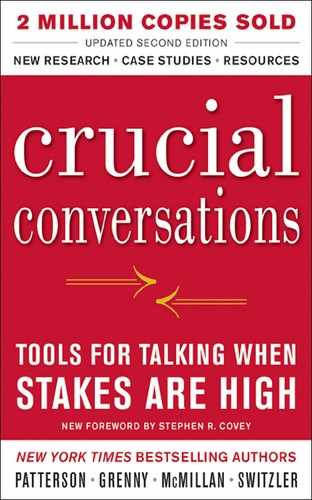REMEMBER YOUR ABCS
Let’s say you did your level best to make it safe for the other person to talk. After asking, mirroring, paraphrasing, and eventually priming, the other person opened up and shared his or her path. It’s now your turn to talk. But what if you disagree? Some of the other person’s facts are wrong, and his or her stories are completely fouled up. Well, at least they’re a lot different from the story you’ve been telling. Now what?
Agree
As you watch families and work groups take part in heated debates, it’s common to notice a rather intriguing phenomenon. Although the various parties you’re observing are violently arguing, in truth, they’re in violent agreement. They actually agree on every important point, but they’re still fighting. They’ve found a way to turn subtle differences into a raging debate.
For example, last night your teenage son broke his curfew again. You and your spouse have spent the morning arguing about the infraction. Last time James came in late, you agreed to ground him, but today you’re upset because it seems like your spouse is backpedaling by suggesting that James still be able to attend a football camp this week. Turns out it was just a misunderstanding. You and your spouse agree to the grounding—the central issue. You thought your spouse was reneging on the agreement when, in truth, you just hadn’t actually resolved the date the grounding would start. You had to step back and listen to what you were both saying to realize that you weren’t really disagreeing, but violently agreeing.
Most arguments consist of battles over the 5 to 10 percent of the facts and stories that people disagree over. And while it’s true that people eventually need to work through differences, you shouldn’t start there. Start with an area of agreement.
So here’s the take-away. If you completely agree with the other person’s path, say so and move on. Agree when you agree. Don’t turn an agreement into an argument.
Build
Of course, the reason most of us turn agreements into debates is because we disagree with a certain portion of what the other person has said. Never mind that it’s a minor portion. If it’s a point of disagreement, we’ll jump all over it like a fleeing criminal.
Actually, we’re trained to look for minor errors from an early age. For instance, we learn in kindergarten that if you have the right answer, you’re the teacher’s pet. Being right is good. Of course, if others have the right answer they get to be the pet. So being right first is even better. You learn to look for even the tiniest of errors in others’ facts, thinking, or logic. Then you point out the errors. Being right at the expense of others is best.
By the time you finish your education, you have a virtual Ph.D. in catching trivial differences and turning them into a major deal. So when another person offers up a suggestion (based on facts and stories), you’re looking to disagree. And when you do find a minor difference, you turn this snack into a meal. Instead of remaining in healthy dialogue, you end up in violent agreement.
On the other hand, when you watch people who are skilled in dialogue, it becomes clear that they’re not playing this everyday game of Trivial Pursuit—looking for trivial differences and then proclaiming them aloud. In fact, they’re looking for points of agreement. As a result, they’ll often start with the words “I agree.” Then they talk about the part they agree with. At least, that’s where they start.
Now when the other person has merely left out an element of the argument, skilled people will agree and then build. Rather than saying: “Wrong. You forgot to mention . . .,” they say: “Absolutely. In addition, I noticed that. . .”
If you agree with what has been said but the information is incomplete, build. Point out areas of agreement, and then add elements that were left out of the discussion.
Compare
Finally, if you do disagree, compare your path with the other person’s. That is, rather than suggesting that he or she is wrong, suggest that you differ. He or she may, in fact, be wrong, but you don’t know for sure until you hear both sides of the story. For now, you just know that the two of you differ. So instead of pronouncing “Wrong!” start with a tentative but candid opening, such as “I think I see things differently. Let me describe how.”
Then share your path using the STATE skills from Chapter 7. That is, begin by sharing your observations. Share them tentatively, and invite others to test your ideas. After you’ve shared your path, invite the other person to help you compare it with his or her experience. Work together to explore and explain the differences.
In summary, to help remember these skills, think of your ABCs. Agree when you agree. Build when others leave out key pieces. Compare when you differ. Don’t turn differences into debates that lead to unhealthy relationships and bad results.
